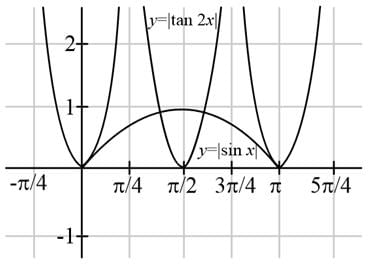JEE Exam > JEE Questions > The number of solutions of equation|tan2x|=si...
Start Learning for Free
The number of solutions of equation |tan2x|=sinx in [0,π] is
- a)2
- b)4
- c)6
- d)8
Correct answer is option 'B'. Can you explain this answer?
Most Upvoted Answer
The number of solutions of equation|tan2x|=sinxin [0,π]isa)2b)4c)6d...
To find the number of solutions for the equation |tan(2x)| = sin(x) in the interval [0, π/2], we can analyze the behavior of each function separately.
First, let's consider the function |tan(2x)|. Since the absolute value function does not affect the number of solutions, we can ignore it for now and focus on the equation tan(2x) = sin(x).
To simplify this equation, we can use the identity sin(2x) = 2sin(x)cos(x). Substituting this identity into the equation, we get:
tan(2x) = sin(x)
tan(2x) = 2sin(x)cos(x)
Now, let's consider the behavior of each function individually.
1) tan(2x): This function has an infinite number of solutions because it is periodic with a period of π. In the interval [0, π/2], there are no vertical asymptotes or points where the tangent function is undefined.
2) sin(x): This function has a maximum of one solution in the interval [0, π/2]. This is because sin(x) is an increasing function in this interval, starting from sin(0) = 0 and reaching its maximum value of sin(π/2) = 1.
Now, let's analyze the equation tan(2x) = 2sin(x)cos(x) in the interval [0, π/2].
Since the function tan(2x) has an infinite number of solutions and sin(x) has at most one solution, there can be at most one solution to the equation in this interval.
Therefore, the number of solutions of the equation |tan(2x)| = sin(x) in the interval [0, π/2] is at most one.
First, let's consider the function |tan(2x)|. Since the absolute value function does not affect the number of solutions, we can ignore it for now and focus on the equation tan(2x) = sin(x).
To simplify this equation, we can use the identity sin(2x) = 2sin(x)cos(x). Substituting this identity into the equation, we get:
tan(2x) = sin(x)
tan(2x) = 2sin(x)cos(x)
Now, let's consider the behavior of each function individually.
1) tan(2x): This function has an infinite number of solutions because it is periodic with a period of π. In the interval [0, π/2], there are no vertical asymptotes or points where the tangent function is undefined.
2) sin(x): This function has a maximum of one solution in the interval [0, π/2]. This is because sin(x) is an increasing function in this interval, starting from sin(0) = 0 and reaching its maximum value of sin(π/2) = 1.
Now, let's analyze the equation tan(2x) = 2sin(x)cos(x) in the interval [0, π/2].
Since the function tan(2x) has an infinite number of solutions and sin(x) has at most one solution, there can be at most one solution to the equation in this interval.
Therefore, the number of solutions of the equation |tan(2x)| = sin(x) in the interval [0, π/2] is at most one.
Free Test
FREE
| Start Free Test |
Community Answer
The number of solutions of equation|tan2x|=sinxin [0,π]isa)2b)4c)6d...
Given that: |tan2x|=sinx in [0,π]
Drawing the graph of y=|tan2x| and y=sinx

Drawing the graph of y=|tan2x| and y=sinx


|
Explore Courses for JEE exam
|

|
Question Description
The number of solutions of equation|tan2x|=sinxin [0,π]isa)2b)4c)6d)8Correct answer is option 'B'. Can you explain this answer? for JEE 2025 is part of JEE preparation. The Question and answers have been prepared according to the JEE exam syllabus. Information about The number of solutions of equation|tan2x|=sinxin [0,π]isa)2b)4c)6d)8Correct answer is option 'B'. Can you explain this answer? covers all topics & solutions for JEE 2025 Exam. Find important definitions, questions, meanings, examples, exercises and tests below for The number of solutions of equation|tan2x|=sinxin [0,π]isa)2b)4c)6d)8Correct answer is option 'B'. Can you explain this answer?.
The number of solutions of equation|tan2x|=sinxin [0,π]isa)2b)4c)6d)8Correct answer is option 'B'. Can you explain this answer? for JEE 2025 is part of JEE preparation. The Question and answers have been prepared according to the JEE exam syllabus. Information about The number of solutions of equation|tan2x|=sinxin [0,π]isa)2b)4c)6d)8Correct answer is option 'B'. Can you explain this answer? covers all topics & solutions for JEE 2025 Exam. Find important definitions, questions, meanings, examples, exercises and tests below for The number of solutions of equation|tan2x|=sinxin [0,π]isa)2b)4c)6d)8Correct answer is option 'B'. Can you explain this answer?.
Solutions for The number of solutions of equation|tan2x|=sinxin [0,π]isa)2b)4c)6d)8Correct answer is option 'B'. Can you explain this answer? in English & in Hindi are available as part of our courses for JEE.
Download more important topics, notes, lectures and mock test series for JEE Exam by signing up for free.
Here you can find the meaning of The number of solutions of equation|tan2x|=sinxin [0,π]isa)2b)4c)6d)8Correct answer is option 'B'. Can you explain this answer? defined & explained in the simplest way possible. Besides giving the explanation of
The number of solutions of equation|tan2x|=sinxin [0,π]isa)2b)4c)6d)8Correct answer is option 'B'. Can you explain this answer?, a detailed solution for The number of solutions of equation|tan2x|=sinxin [0,π]isa)2b)4c)6d)8Correct answer is option 'B'. Can you explain this answer? has been provided alongside types of The number of solutions of equation|tan2x|=sinxin [0,π]isa)2b)4c)6d)8Correct answer is option 'B'. Can you explain this answer? theory, EduRev gives you an
ample number of questions to practice The number of solutions of equation|tan2x|=sinxin [0,π]isa)2b)4c)6d)8Correct answer is option 'B'. Can you explain this answer? tests, examples and also practice JEE tests.

|
Explore Courses for JEE exam
|

|
Signup for Free!
Signup to see your scores go up within 7 days! Learn & Practice with 1000+ FREE Notes, Videos & Tests.























